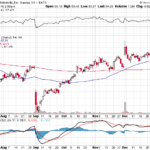Average True Range (ATR) is a technical analysis indicator of a security’s volatility. Although it was originally developed for commodities, ATR can also be used for stocks. It is a measure of the average trading range of a stock each day. If you look at a stock candlestick daily chart, you will see the high and low for the day, in addition to the last or closing price for the day. The height of the chart is the trading range. Average those daily trading ranges over some time using Calculus, and you calculate the ATR.
Volatility Measure
Beta is the most used measure of a stock’s Volatility, but Beta is a measure of Volatility in relation to the S&P 500 Index. ATR, on the other hand, is a measure of absolute Volatility, meaning it is in relation to itself, not to an index. It answers the question, “How wide a range does this stock trade in each day?”, instead of “How does this stock trade in relation to the S&P 500 Index?”, which is answered by a stock’s Beta coefficient.
Day Traders
Day Traders like stocks that have a high ATR because daily trading range volatility means profit opportunities for Day Traders. Day Trading also probably contributes to a stock’s ATR – a stock that is highly day-traded probably has a higher ATR because of the day-trading activity. Smaller tech companies tend to have relatively high ATRs, whereas established “old economy” companies such as utilities have lower ATRs.
Stock Chart Sites
Free stock chart sites Stockcharts.com and Finviz.com will tell you a stock’s ATR. I don’t see it on Yahoo! Finance but perhaps I am missing it. In Stockcharts, you select ATR in the Indicators section below the chart. In Finviz, ATR is also listed below the chart with no additional selection by you required.
Whole Number vs. Percentage
Average True Range is calculated as a whole number. Thus, higher-priced stocks such as Amazon, at $1,259 per share, have a larger ATR than do lower-priced stocks. To get a true measure of the ATR, divide the ATR number by the stock price. This will give you a percentage trading range, which will help you determine which stocks are truly volatile and which are less so.
AMBA
One stock that I follow but don’t own is Ambarella, Inc. (AMBA), a chipmaker whose products are used in GoPro cameras, among other customers. Here is a chart of AMBA as I write this post:

AMBA has an ATR of 2.42, which, when divided by its current price (as I write this) of $54.32, means that its ATR is 4.45% of its stock price. That’s very high! It means that, on an average day, AMBA trades within a range of 2.42 points or 4.45% of its value. Compare that with the SPY, the S&P 500 Index ETF, which has an ATR of 1.56 or 0.6% of its stock price of $275.62. AMBA is much more volatile. If you are looking for a stock with large price swings on a daily basis, AMBA is one possibility. There are many others.
Other Applications
I believe the concept of Average True Range can be applied to other aspects of life. For instance, do you know people where you don’t know what to expect next? And do you know people who seem to be very steady and even-tempered? Perhaps you work or go to school with both types of people. The former can be said to have a high ATR, while the latter can be said to have a low ATR. I used to use High Beta and Low Beta to describe these personality traits, but I think I will start using ATR instead because they are volatile in and of themselves and not in relation to greater society. High ATR people tend to have a lot of drama surrounding them. Sometimes you can handle the drama, or even crave it, and sometimes you want less drama, perhaps because you have more drama going on in your own life at that time. The same holds true for stocks. It doesn’t imply that higher ATR people have a higher upside, just that the highs and lows they and you experience throughout an average day are wide, and wider than those of other people.
IMO
I am pointing out ATR as another item to look at when looking at individual stocks. It doesn’t work as well for funds or indexes because of the many holdings within a fund or an index. Please let me know any thoughts you have and perhaps if this helps you think differently about your interactions with other people.
